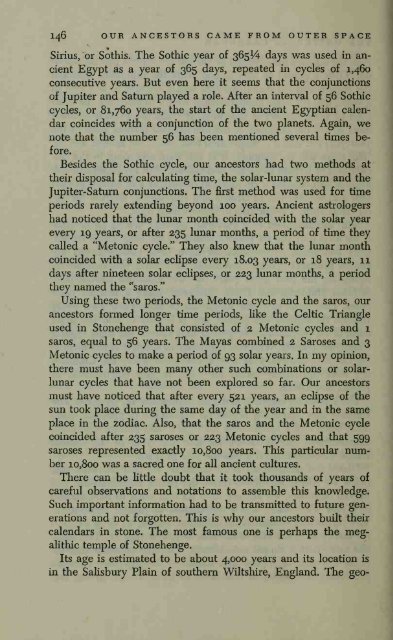Create successful ePaper yourself
Turn your PDF publications into a flip-book with our unique Google optimized e-Paper software.
146 OUR ANCESTORS CAME FROM OUTER SPACE<br />
Sirius, or Sethis. The Sothic year of 365 Vi days was used in ancient<br />
Egypt as a year of 365 days, repeated in cycles of 1,460<br />
consecutive years. But even here it seems that the conjunctions<br />
of Jupiter and Saturn played a role. After an interval of 56 Sothic<br />
cycles, or 81,760 years, the start of the ancient Egyptian calendar<br />
coincides with a conjunction of the two planets. Again, we<br />
note that the number 56 has been mentioned several times<br />
before.<br />
Besides the Sothic cycle, our ancestors had two methods at<br />
their disposal for calculating time, the solar-lunar system and the<br />
Jupiter-Saturn conjunctions. The first method was used for time<br />
periods rarely extending beyond 100 years.<br />
Ancient astrologers<br />
had noticed that the lunar month coincided with the solar year<br />
every 19 years, or after 235 lunar months, a period of time they<br />
called a "Metonic cycle.*' They also knew that the lunar month<br />
coincided with a solar ecHpse every 18.03 years, or 18 years, 11<br />
days after nineteen solar eclipses, or 223 lunar months, a period<br />
they named the "saros."<br />
Using these two periods, the Metonic cycle and the saros, our<br />
ancestors formed longer time periods, like the Celtic Triangle<br />
used in Stonehenge that consisted of 2 Metonic cycles and 1<br />
saros, equal to 56 years. The Mayas combined 2 Saroses and 3<br />
Metonic cycles to make a period of 93 solar years. In my opinion,<br />
there must have been many other such combinations or solarlunar<br />
cycles that have not been explored so far. Our ancestors<br />
must have noticed that after every 521 years, an eclipse of the<br />
sun took place during the same day of the year and in the same<br />
place in the zodiac. Also, that the saros and the Metonic cycle<br />
coincided after 235 saroses or 223 Metonic cycles and that 599<br />
saroses represented exactly 10,800 years. This particular number<br />
10,800 was a sacred one for all ancient cultures.<br />
There can be little doubt that it took thousands of years of<br />
careful observations and notations to assemble this knowledge.<br />
Such important information had to be transmitted to futiure generations<br />
and not forgotten. This is why our ancestors built their<br />
calendars in stone. The most famous one is perhaps the megalithic<br />
temple of Stonehenge.<br />
Its age is estimated to be about 4,000 years and its location is<br />
in the Salisbury Plain of southern Wiltshire, England. The geo-

















